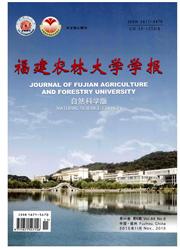

 中文摘要:
中文摘要:
采用稻稗抑草圈土壤盆栽种植方法,微波萃取和气质联用色谱技术测定苗期强化感水稻PI312777与非化感水稻Lemont的茎、叶中萜种类及总萜、单萜、含氧单萜浓度,并进行比较分析.根据物质分析结果,进一步考察含氧萜类对稗草的抑制能力.结果表明:化感水稻PI312777显著抑制其周围稗草的生长,且其苗期茎叶中总萜、单萜以及含氧单萜含量均高于非化感水稻Lemont.验证结果表明,所选择的7种含氧单萜的混合溶液对稗草的株高和干重的抑制作用随着浓度的增高而升高,且低浓度的含氧单萜混合溶液对常规水稻Ⅱ优航无危害作用,因此化感水稻苗期自然分泌的含氧单萜物质是一种潜在的生态安全除草剂.
 英文摘要:
英文摘要:
In order to explore the effect of terpenoids from allelopathic rice on paddy weed,allelopathic rice cultivar PI312777,nonallelopathic rice cultivar Lemont,and barnyardgrass( Echinochloa crusgalli L.) were mixed cultured by inhibitory circle method in pot experiment with paddy soil,with the distance between rice and barnyardgrass being 12 cm. Contents of total terpenoid,monoterpenoid,and oxygenated monoterpenoid in the leaves and stem of rice seedlings were determined by GC-MS technique with microwave-assisted extraction. The results showed that the allelopathic rice PI312777 effectively suppressed the growth of adjacent barnyardgrass,and the contents of total terpenoids,monoterpenoids,and oxygenated monoterpenoids were higher in the leaves and stems of rice PI312777 than those in Lemont. Inhibitory effect of mixture of the target oxygenated monoterpenoids enhanced with the increased concentrations of the mixed solutions,while without inhibitory effect from conventional rice cultivar,Ⅱ Youhang,at low concentration. In conclusion,oxygenated monoterpenoids potentially could be used as an ecological herbicide.
 同期刊论文项目
同期刊论文项目
 同项目期刊论文
同项目期刊论文
 期刊信息
期刊信息
